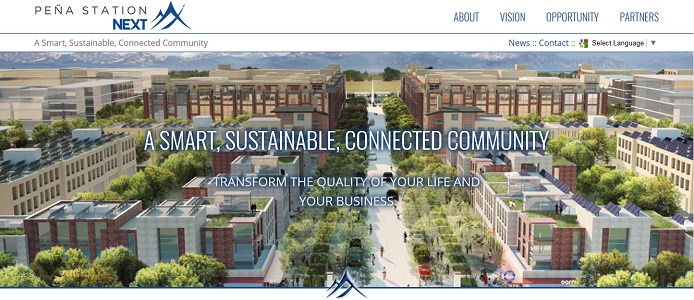A Carbon-Free City is Being Built From Scratch
Read the entire article at Scientific American.
Can a city built from scratch be profitable to developers and enjoyable to residents as it tries to be carbon-free? That is the question facing owners and planners of a mostly vacant, sunburned 400-acre plot of land near this city’s sprawling International Airport as they plan an energy system with vast differences from the typical suburban subdivision.
The city, called Peña Station Next, is located at the last stop of Denver’s newly completed rail line to its airport. It’s named after Federico Peña, a former mayor and lawyer whose adroit political maneuvering helped to site both the airport and the rail line at their present location over 30 years ago.
Denver and Denver County, which own Denver International Airport, will contribute financial support for the project and the sunshine falling on the canopy of its massive parking lot. Xcel Energy Inc., the local utility, will collect it with solar arrays and contribute a 1-megawatt, grid-connected battery to provide backup power and other services to Peña Station Next.
The battery will be connected to a building being completed by Panasonic, the Japanese-based global conglomerate. The project was inspired by a smaller-scale effort it initiated in Fujisawa, a suburb of Tokyo. That “sustainable smart town,” which cut its CO2 emissions by 70 percent, was inaugurated three years ago, and property values have risen by 25 percent.
So Panasonic, which fancies itself as a “technology integrator,” began to think bigger. After getting proposals from 20 U.S. cities, it chose Denver for a project 10 times larger than Fujisawa. The developer that owns the land near the airport, L.C. Fulenwider Inc., was excited.
The price of solar power has been dropping sharply, and the cost of battery storage may be less than half of today’s price by 2025, according to a paper produced by Panasonic. It predicts that energy storage will soon become the “Swiss Army knife” of the nation’s power grid as a “flexible, nimble resource that can benefit utilities, customers and the entire power grid.”
Most microgrids in the United States are managed by one owner — usually a college campus or a military base — that builds the grid to protect itself from power outages. Panasonic found that other companies were interested in joining it in the Denver project. “We saw that and sat down with Xcel and NREL and said, ‘How can we do this at a much larger scale?'” recalled Panasonic’s Matthew Crosby, program manager for the project.
One result of that has been research on the potential for other common, low-carbon energy systems at the site. They include common heating and cooling systems, more rooftop solar cells, a way of making methane from sewage, and even a look at designing a regenerative braking system to extract electricity from the airport trains that stop at Peña Station Next every 15 minutes.



